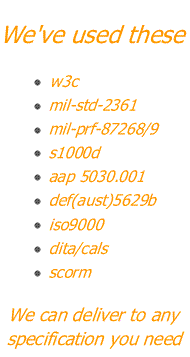Specifications
Standards, specifications and procedures. They seem to be everywhere these days. Love them or hate them, the fact is that they're a significant part of modern industry. Especially in the area of sophisticated technical equipment associated with complex and hazardous operations.
Regardless of how we might individually feel about specifications, they must be respected. Many have been determined through hard lessons learnt, prudent hindsight and even wiser foresight. Others seem to have been created purely for annoyance. The point is that professionals must be knowledgeable about them, understand them and ensure compliance. But which ones?
W3C Organisation
In our industry, one set of standards stands out head and shoulders above the rest: the W3C Organisation. These people have set the standards and published the specifications for all web professionals involved in all aspects of electronic web media since the Internet began. And IETMs are web technology; SGML, HTML, XML, XHTML, including Scalable Vector Graphics (SVG). W3C specifications are our industry standard and we adhere rigidly to them as the overriding authority in all our originally created products. We ensure compliance of all our IETM products by rigorous validation checking and cross platform browser testing.
Individual industry specifications
By the time the data of a finished IETM is served to a user, it may be the culmination of a dozen or more different sets of standards, legislation and regulations. Starting right from the outset, company operations, the design process, manufacture, testing, production, certification, warehousing, delivery, customer acceptance, everyone's QA and subsequently, even the final end user may have compliance requirements.
No single professional along the production chain can be expected to know everything about everyone else's specifications, but we have years of experience working with many varied industries and we can create compliant technical documentation to any standard or specifications you require.


